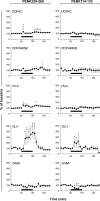Discovering new bioactive neuropeptides in the striatum secretome using in vivo microdialysis and versatile proteomics
- PMID: 19164277
- PMCID: PMC2689773
- DOI: 10.1074/mcp.M800501-MCP200
Discovering new bioactive neuropeptides in the striatum secretome using in vivo microdialysis and versatile proteomics
Abstract
The striatum, a major component of the brain basal nuclei, is central for planning and executing voluntary movements and undergoes lesions in neurodegenerative disorders such as Huntington disease. To perform highly integrated tasks, the striatum relies on a complex network of communication within and between brain regions with a key role devoted to secreted molecules. To characterize the rat striatum secretome, we combined in vivo microdialysis together with proteomics analysis of trypsin digests and peptidomics studies of native fragments. This versatile approach, carried out using different microdialysis probes and mass spectrometer devices, allowed evidencing with high confidence the expression of 88 proteins and 100 processed peptides. Their secretory pathways were predicted by in silico analysis. Whereas high molecular weight proteins were mainly secreted by the classical mode (94%), low molecular weight proteins equally used classical and non-classical modes (53 and 47%, respectively). In addition, our results suggested alternative secretion mechanisms not predicted by bioinformatics tools. Based on spectrum counting, we performed a relative quantification of secreted proteins and peptides in both basal and neuronal depolarization conditions. This allowed detecting a series of neuropeptide precursors and a 6-fold increase for neurosecretory protein VGF and proenkephalin (PENK) levels. A focused investigation and a long peptide experiment led to the identification of new secreted non-opioid PENK peptides, referred to as PENK 114-133, PENK 239-260, and PENK 143-185. Moreover we showed that injecting synthetic PENK 114-133 and PENK 239-260 into the striatum robustly increased glutamate release in this region. Thus, the combination of microdialysis and versatile proteomics methods shed new light on the secreted protein repertoire and evidenced novel neuropeptide transmitters.
Figures








References
-
- Yin, H. H., and Knowlton, B. J. ( 2006) The role of the basal ganglia in habit formation. Nat. Rev. Neurosci. 7, 464–476 - PubMed
-
- Nauta, W. J. H. ( 1989) Reciprocal links of the corpus striatum with the cerebral cortex and limbic system: a common substrate for movement and thought?, in Neurology and Psychiatry: a Meeting of Minds (Mueller, J., ed) pp. 43–63, S. Karger AG, Basel
-
- Nickel, W. ( 2005) Unconventional secretory routes: direct protein export across the plasma membrane of mammalian cells. Traffic 6, 607–614 - PubMed
-
- Keller, M., Ruegg, A., Werner, S., and Beer, H. D. ( 2008) Active caspase-1 is a regulator of unconventional protein secretion. Cell 132, 818–831 - PubMed
Publication types
MeSH terms
Substances
LinkOut - more resources
Full Text Sources
Molecular Biology Databases
Miscellaneous

